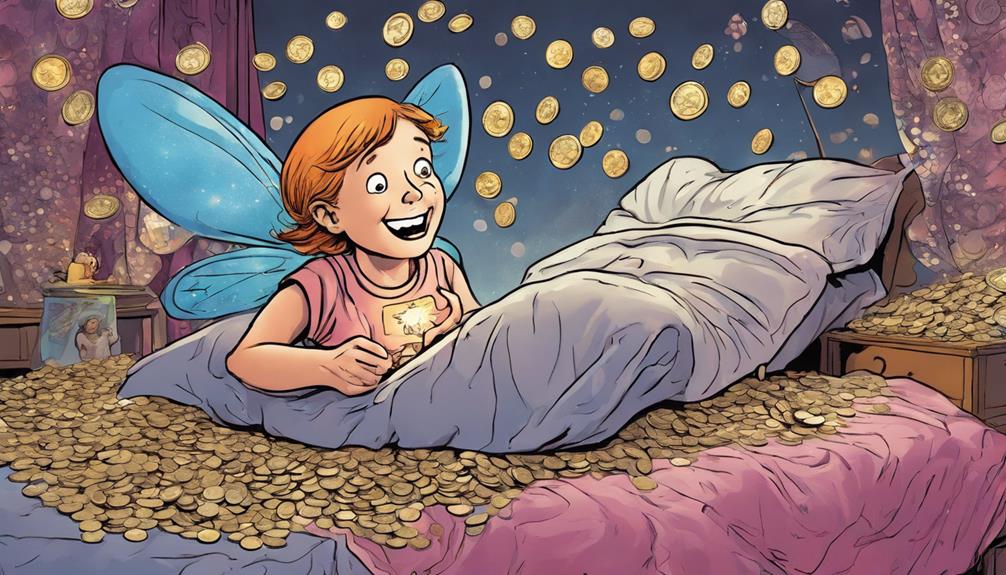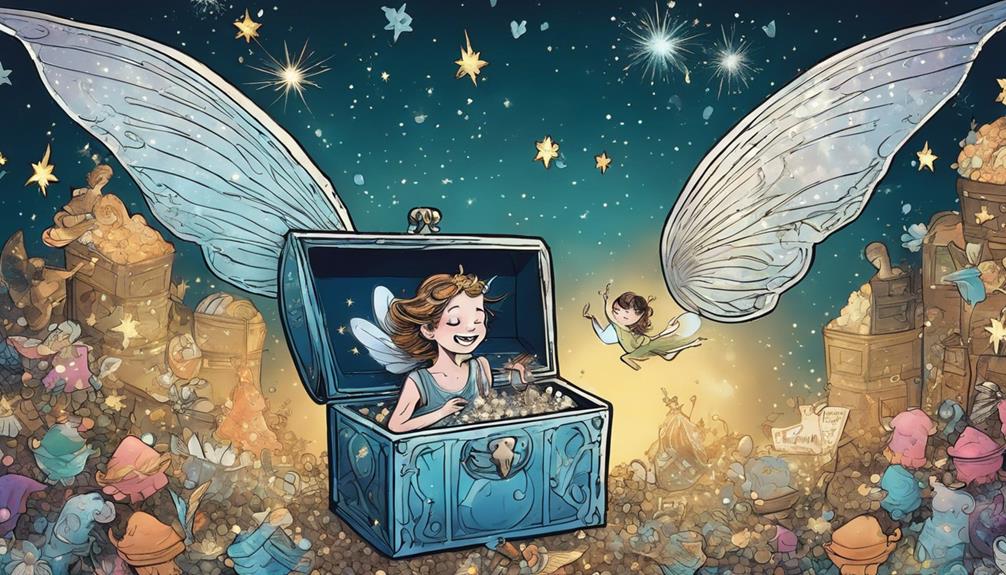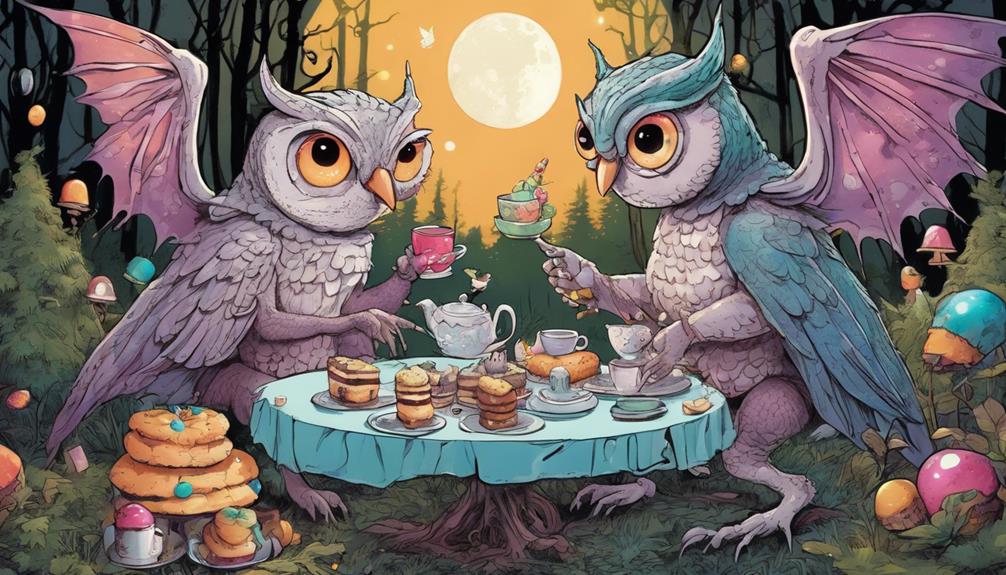Parents often find themselves torn over the Tooth Fairy's most controversial decisions. Balancing the beloved tradition with rising costs can feel overwhelming. You might struggle to keep up as the average payment for lost teeth climbs higher. Plus, the emotional impact of disillusionment when kids discover the truth can create tension and trust issues. Many want to preserve the magic but also foster honesty, leading to challenging conversations. Steering through financial stress and emotional needs becomes a tightrope walk. If you want to explore what other parents think and how they manage these concerns, there's more to uncover.
Key Takeaways
- Rising payouts for lost teeth create pressure among parents, leading to debates on appropriateness and fairness within the Tooth Fairy tradition.
- Parents experience stress during stealthy exchanges, prompting discussions about simplifying rituals and sharing responsibilities with partners.
- The transition from belief in the Tooth Fairy to understanding reality can cause emotional distress, impacting children's trust in relationships.
- Open conversations about magic and truth are essential as children navigate their beliefs, validating feelings of disappointment fosters trust and communication.
The Origins of the Tooth Fairy
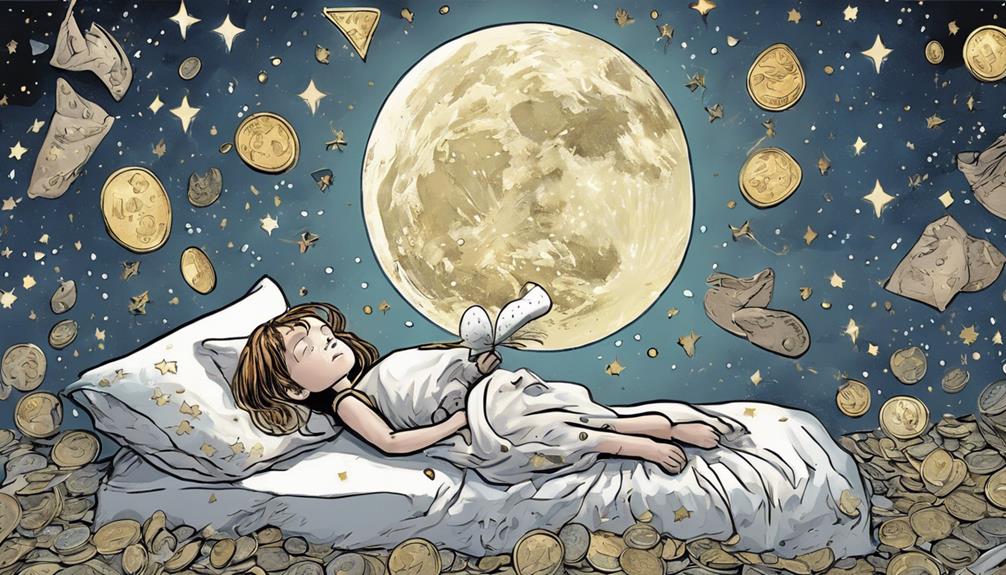
The Tooth Fairy tradition traces its roots back to Northern Europe, where people participated in rituals that involved burying or burning baby teeth for good luck and health. This practice was steeped in cultural beliefs that losing a tooth was significant, often tied to childhood milestones.
You might find it fascinating that the modern concept of a fairy exchanging money for these lost teeth emerged in the early 20th century, evolving alongside other childhood myths like Santa Claus.
As a child, you probably enjoyed the make-believe aspect of the Tooth Fairy, enthusiastically placing your tooth under your pillow, anticipating the magical exchange. Different cultures have their unique spins on this tradition; for instance, in Spain and parts of Latin America, children look forward to the Ratoncito Pérez, a mouse that collects teeth instead.
The lack of a standardized description for the Tooth Fairy means that she can be whatever your imagination conjures—whimsical, humorous, or even a bit bizarre. This flexibility reflects the broad cultural values surrounding childhood growth and magical thinking, making the Tooth Fairy a beloved figure in many homes.
Parental Stress During Exchanges

Steering the stealthy exchange of money for lost teeth often leaves parents feeling overwhelmed and anxious. You might find yourself tiptoeing through dark rooms, trying not to make a sound as you swap cash for a tooth. This chaotic ritual can lead to significant parental stress, as the pressure to maintain the magic of the Tooth Fairy weighs heavily on your shoulders.
Many parents have considered simplifying the process by writing checks during daylight to avoid the nighttime frenzy. After all, it's a good idea to reduce stress whenever possible, especially when you're juggling multiple responsibilities. Some parents negotiate roles with their partners, trading responsibilities to help manage the madness of the Tooth Fairy exchange more effectively.
Despite these challenges, the tradition remains a cherished part of childhood. You endeavor to create a sense of wonder for your children, even amidst the chaos. Balancing the excitement of the Tooth Fairy with the realities of parental stress can be tough, but finding practical solutions can help you enjoy this magical moment without feeling overwhelmed.
Embracing teamwork and planning ahead can make all the difference in keeping the tradition alive.
Financial Aspects of Tooth Loss

Parents often grapple with the rising costs associated with the Tooth Fairy tradition as the value of a lost tooth continues to increase. The average payment has jumped from $3.70 in 2013 to $6.23 in 2023, creating a financial burden for many families. With children losing about 20 baby teeth, that totals around $74 per child.
You might notice some parents are taking this tradition to extremes, and it's sparking debates about what's appropriate. Here are a few points to reflect on:
- The average payment has increased considerably over the years.
- Some parents report giving extravagant amounts, even up to $100.
- Kids often compare Tooth Fairy gifts, leading to pressure among parents.
As these payments rise, parents face the challenge of balancing tradition with their budget. It's vital to find a personal approach that works for your family while weighing the implications of the financial burden this tradition may bring.
After all, the Tooth Fairy should bring joy, not stress!
Cultural Variations in Belief

Cultural beliefs about tooth loss vary widely, showcasing unique customs and mythical figures that replace the Tooth Fairy in different regions. For instance, in Spain and several Latin American countries, kids enthusiastically await Ratoncito Pérez, a mouse that collects lost teeth and leaves small rewards in return. Similarly, Italy has its version with Topolino, while in France, children may find their lost teeth replaced by La Petite Souris, another mouse-like figure.
However, not all cultures rely on these characters. Some traditions focus on rituals instead; for example, some families bury the lost tooth or toss it onto the roof. These practices are believed to promote the growth of healthy adult teeth.
The perception of the Tooth Fairy and the expectations surrounding it can differ greatly among children, often influenced by familial customs and local traditions. These cultural variations shape how kids experience the magic of losing a tooth, whether through a fairy tale or a mouse's visit.
Understanding these differences not only enriches your appreciation of childhood beliefs but also highlights the diverse ways families celebrate this universal milestone.
Emotional Impact of Disillusionment

Discovering the truth about the Tooth Fairy can lead to intense emotional responses in children, often leaving them feeling heartbroken and embarrassed for having believed in the myth. This disillusionment can create significant emotional distress, manifesting as tears and disappointment. As a parent, your role becomes vital during this challenging shift.
Consider these emotional impacts on your child:
- Heartbreak: They may mourn the loss of magic, feeling sad that something they cherished isn't real.
- Embarrassment: Children might feel foolish for having believed in a story that now seems childish.
- Trust Issues: This revelation can shape how they perceive honesty and trust in your relationship.
Navigating this emotional landscape requires sensitivity. While you might wrestle with the discomfort of maintaining the myth versus embracing honesty, it's important to support your child through their feelings.
Acknowledging their emotional distress can help them process their experience while preserving the wonder of childhood in a more nuanced way.
Conversations About Magic and Reality
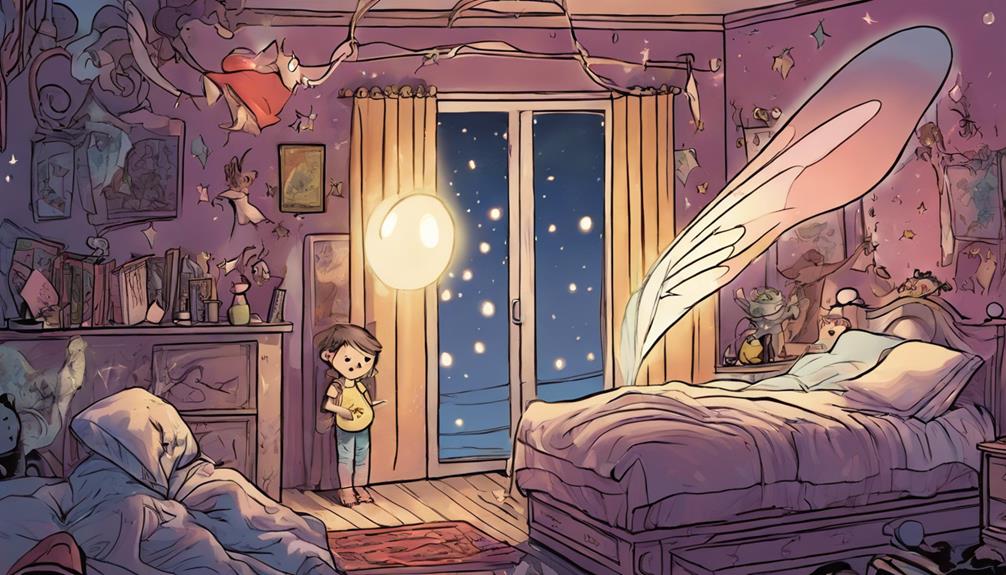
When you talk to your child about the Tooth Fairy, you're balancing their belief in magic with the truth of reality.
Consider how their age influences their understanding, as older kids might question these figures more critically.
These conversations can help you connect with your child while nurturing their imagination.
Balancing Belief and Truth
Guiding the delicate balance between belief in magical figures like the Tooth Fairy and understanding reality can be a challenging yet enriching experience for both children and parents. Engaging in open discussions about these topics allows you to explore your child's thoughts and feelings while helping them navigate the shift from belief to truth.
Consider these key points as you facilitate the conversation:
- Encourage open dialogue: Ask your child what they believe about the Tooth Fairy and listen to their responses.
- Validate their feelings: Recognize that disappointment or confusion may arise when confronting the truth.
- Share traditions: Discuss the joy of magic and the importance of imagination in childhood.
Age-Appropriate Understanding
As children grow, their ability to differentiate between magic and reality shifts, prompting significant conversations about figures like the Tooth Fairy. Engaging with your child about their beliefs can help foster trust and communication. Here's a simple guide to navigate these discussions:
| Age Range | Understanding of the Tooth Fairy |
|---|---|
| 3-5 years | Believes wholeheartedly in the Tooth Fairy |
| 6-7 years | Starts to show skepticism but enjoys the magic |
| 8-9 years | May question the reality, seeking reassurance |
| 10+ years | Often understands the truth but may play along |
| Cultural Impact | Varies; some families emphasize magic, others promote honesty |
As skepticism increases, you might face questions about the Tooth Fairy's existence. It's essential to find a balance between maintaining the wonder of childhood and promoting honesty. Additionally, consider how conversations about the Tooth Fairy can address bad behaviour. When children misbehave, reminding them of the Tooth Fairy's values can serve as a gentle nudge towards better behavior. Ultimately, guiding your child through these stages helps them develop a healthy understanding of magic versus reality.
Parenting Perspectives on Myths

As a parent, you might struggle with how to balance the magic of the Tooth Fairy and the truth you want to instill in your child. One approach could be to let your child enjoy the wonder and excitement of the Tooth Fairy while also gently guiding them towards understanding that it’s a fun tradition rather than a literal being. You can use the tooth fairy mishap as an opportunity to have an open and honest conversation about the meaning behind the tradition and the importance of imagination. This way, your child can still experience the joy of the Tooth Fairy while also developing a strong sense of reality and critical thinking.
The emotional impact of disillusionment can be significant, especially when kids connect their behavior to the myth.
It's essential to reflect on how your approach shapes their understanding of both magic and reality.
Balancing Truth and Magic
While many parents cherish the magic of the Tooth Fairy, they often struggle to balance this enchanting myth with the importance of honesty in their parenting. You might find it challenging to navigate your child's belief in the Tooth Fairy while also instilling values of truthfulness. The key is to create a space where both magic and honesty coexist.
Consider these points:
- Cultural Traditions: Blend your family's cultural influences with personal beliefs about childhood magic.
- Positive Reinforcement: Use the Tooth Fairy as a tool for encouraging your child to behave well, turning the myth into a lesson.
- Open Discussions: Engage your child in conversations about magical figures, allowing them to express their thoughts and feelings.
Ultimately, striking a balance between the Tooth Fairy's enchantment and the value of honesty can enrich your parenting experience, helping your child appreciate both wonder and truth.
Emotional Impact of Disillusionment
The emotional fallout when children discover the truth about the Tooth Fairy can deeply affect their sense of trust and wonder. For many kids, this revelation brings feelings of heartbreak and disappointment, as they grapple with the loss of a beloved childhood myth. You might notice your child crying or expressing embarrassment for having believed in something that isn't real. This emotional investment in the myth underscores how pivotal these stories are in shaping their early experiences. It’s important for parents to handle the “tooth fairy incident” with care and sensitivity, acknowledging their child’s feelings and reassuring them that it’s okay to feel disappointed. Encouraging open communication and helping them understand the value of imaginative play and storytelling can also help children navigate this transition. Ultimately, this experience can be a chance for kids to learn about the difference between fantasy and reality, and to appreciate the magic of childhood memories.
As a parent, you may find yourself wrestling with discomfort over the idea of lying, which complicates your discussions about trust and honesty. When the truth emerges, it can alter how your child perceives reality and their relationship with you. The change from belief to understanding isn't always easy, and older children often respond with more pronounced disappointment when confronted with the truth.
Encouraging open discussions can help ease this emotional shift, but it's crucial to approach it with sensitivity. Recognizing their feelings and validating their disappointment can strengthen your bond, allowing your child to navigate this change while maintaining trust in you.
Creative Discipline Strategies
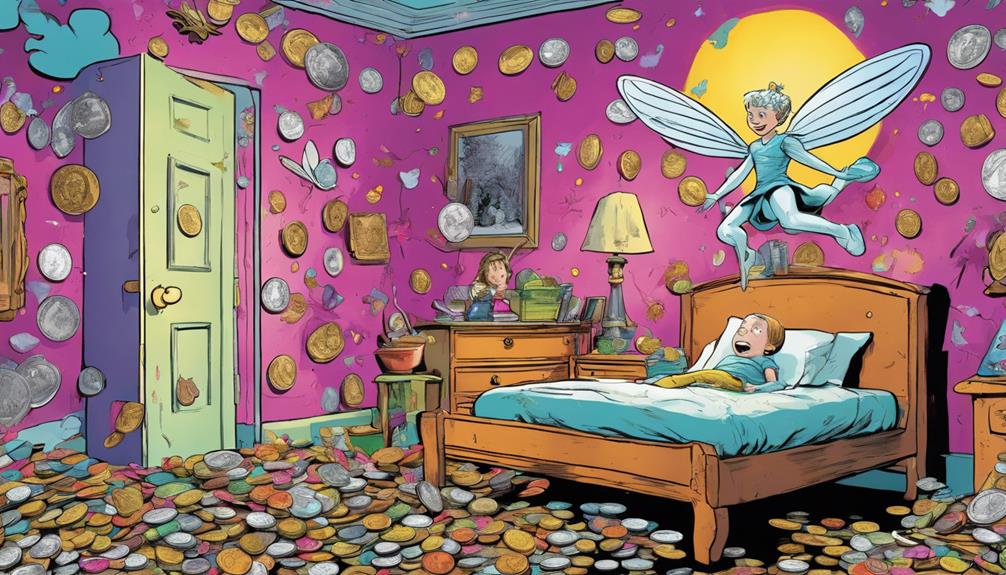
Using imaginative figures like the Tooth Fairy can transform discipline into a more engaging and relatable experience for children. By integrating this magical character into your discipline strategies, you can foster a positive environment that encourages good behavior. Parents have found success using letters from the Tooth Fairy to convey behavioral messages, reinforcing the idea that good deeds earn a spot on the nice list.
Here are some creative strategies you might consider:
- Tooth Fairy Letters: Write personalized notes that praise good behavior or gently address areas for improvement.
- Behavioral Rewards: Offer small rewards from the Tooth Fairy for completing chores or showing kindness, reinforcing positive actions.
- Storytelling: Share tales about the Tooth Fairy observing children and rewarding them for good choices, making lessons more relatable.
These approaches not only maintain the enchantment of childhood myths but also help instill values in a way that feels magical rather than punitive.
Balancing discipline with creativity can lead to meaningful lessons for your little ones.
Frequently Asked Questions
Do Parents Pretend to Be the Tooth Fairy?
Yes, many parents do pretend to be the Tooth Fairy. They create magical experiences for their kids, leaving money or gifts under pillows while encouraging good dental hygiene and making the shift to adult teeth exciting.
How to Explain Tooth Fairy Isn't Real?
You might say the Tooth Fairy is a beautiful story that adds magic to growing up. When you reveal the truth, frame it as a shift into understanding, celebrating imagination while embracing honesty in your relationship.
At What Age Should Kids Stop Believing in the Tooth Fairy?
Most kids stop believing in the Tooth Fairy around age 8, but it varies. You should consider their maturity and curiosity; it's important to gauge when they're ready for the truth about childhood myths.
Should Children Be Told to Believe in Santa Claus and the Tooth Fairy Speech?
You don't want to throw cold water on childhood magic. Encouraging belief in Santa Claus and the Tooth Fairy can spark joy and imagination, but balance honesty with wonder, so your child feels secure and loved.
Conclusion
In the grand tapestry of childhood, the Tooth Fairy weaves threads of wonder and doubt.
As you navigate this delicate balance, remember that every dollar left beneath a pillow symbolizes more than just a financial exchange; it's a fleeting moment of magic in your child's life.
Embrace the whispers of fantasy, for they prepare young hearts for the truths of adulthood.
In nurturing these beliefs, you're not just fostering imagination, but also teaching resilience in the face of reality.
